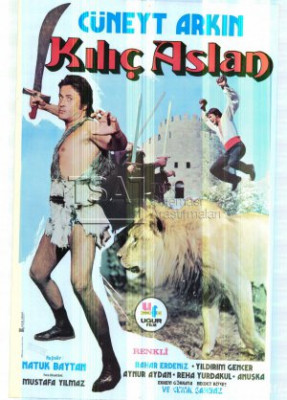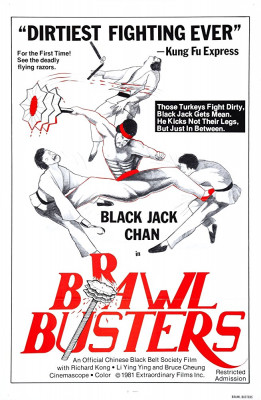| Reviews & Columns |
|
Reviews DVD TV on DVD Blu-ray 4K UHD International DVDs In Theaters Reviews by Studio Video Games Features Collector Series DVDs Easter Egg Database Interviews DVD Talk Radio Feature Articles Columns Anime Talk DVD Savant Horror DVDs The M.O.D. Squad Art House HD Talk Silent DVD
|
DVD Talk Forum |
|
|
| Resources |
|
DVD Price Search Customer Service #'s RCE Info Links |
|
Columns
|
|
|
Sword and the Claw, The
The first of these is The Sword and the Claw (Kiliç Aslan, 1975), a wild-and-wooly example of "Turksploitation," paired with a lively South Korean martial arts film, The Brawl Busters (Sa-dae-tong-iue-moon, 1978). Additionally, trailers for other profoundly weird action films, mostly mind-bending Italian superhero movies, accompany the disc. Everything is presented in high-def, The Sword and the Claw via a "new 4K scan of the only 35mm theatrical print in existence," and The Brawl Busters via a new 2K scan. The trailers are high-def transfers, too.
Needless to say, these movies are not for all tastes but both features are enjoyable on their own terms, incredible even, and nearly indescribable, a perfect double-bill for a Saturday night with a gaggle of receptive friends.
Turksploitation is a fascinating back alley of moviedom, consisting of theatrical films (apparently all shot in 35mm) made primarily in the 1970s and ‘80s, most of which blatantly adapt Hollywood's biggest hits for the domestic Turkish market. They include a Turkish Star Trek (Turist Omer Uzay Yolunda , 1973), a Turkish Exorcist (Seytan, 1974), a Turkish Star Wars ( Dünyayı Kurtaran Adam , 1982), and so forth. These movies went well beyond the common Hong Kong practice of "borrowing" music tracks from other movies (John Barry and Ennio Morricone were especially popular), instead lifting whole scenes and trademarks with impunity. For that reason, presumably, few of these pictures are legally available on DVD or Blu-ray.
The Sword and the Claw is highly derivative, but more or less original in terms of content. The basic plot is borrowed from 1958's The Vikings (and its variations, such as Mario Bava's Erik the Conqueror, 1961). Scheming Commander Antoine (Yildrim Gencer, a Lee Van Cleef type) assassinates beloved King Solomon/Suleiman and enters into a forced marriage with Solomon's lover, Princess Maria (Nazan Adali). Princess Alumnia, carrying Solomon's baby manages to escape but dies soon after childbirth. The baby boy is raised by a pride of lions (a couple of split-screen shots and dangerous-looking footage of a young boy playing with a cub), growing into a Turk Tarzan, called "Lionman" in the English version. Back at the castle, Alumnia gives birth to another son, Altar, which Antoine thinks is biologically his but which is actually another son of Solomon, evidenced by the "birthmark" the siblings share, an elaborate line-drawn tattoo. Cemil Sahbaz, who played Capt. Kirk in the Turkish Star Trek, plays Altar as an adult.
A mishmash of Tarzan, Conan the Barbarian, Shaw Bros., and The Vikings, set in a threadbare Ray Harryhausen Sinbad universe, The Sword and the Claw is cheap but, as defenders of Turksploitation films point out, it's also undeniably exuberant.
Genre star Cüneyt Arkin gamely throws himself (literally) into every scene. Hardly a moment goes by when he's not leaping through his action paces from one hidden trampoline to the next, with Bruce Lee-like grimaces and less skillful but energetic kicks and punches. Initially he has almost no dialogue, making Johnny Weissmuller's "Me Tarzan, you Jane" positively garrulous by comparison. Then, inexplicably, toward the end of the picture he has a long dialogue scene using words he never heard before.
Not that it matters. The English dubbing is among the worst ever, far inferior to the most obscure Asian chop-socky. Clearly, the dubbing cast consists of non-actors who don't even try; their limp dishwater line readings only add to the film's surreal quality.
The picture is cheap (in U.S. terms, probably $75,000-$100,000) yet elaborate, with dozens of costumed extras, colorful set decoration and props. Clearly much improvisation was necessary: Antoine's soldiers, for instance, wear what look like plastic construction worker helmets worn backwards and painted metallic. A few of the leads wear ordinary shirts with modern buttons. And yet the desire to entertain with virtually non-stop action and broad character types is obvious. One imagines local audiences eating it up. They must have: a sequel, Lionman II: The Witch Queen followed in 1979.
Still, the film has a loopy logic that, at times, is mesmerizingly bizarre. When Lionman valiantly holds back Antione's men at the palace, sacrificing his hands when the despot pours burning acid on them (a fairly well-staged sequence, actually), one of the revolutionary suggests "a blacksmith who knows a little bit about medicine." Facing useless hands, Lionman orders the sweaty, sooty blacksmith to construct new ones patterned after razor-sharp lion claws. Sure, no problem. The score mostly quotes Khachaturian's Spartacus, but the classical passages are often totally at odds with what's onscreen.
The co-feature begins with the incredible opening titles "The Chinese Black Belt Society and Extraordinary Films Presents Black Belt Chan in The Brawl Busters." Cut to the movie, actually from South Korea, and then back to the opening titles for a few extraneous frames. Oops!
Whomever Black Belt Chan might be, the story in fact revolves around a female protagonist, Kow Ling-Yen of what sounds like "Verity Lodge" (?), seeking revenge from four cackling, scenery-chewing bad guys, leaders of the Tung-Cheng school, who murdered her parents when she was a baby. Accompanied by four female helpers, Kow Ling-Yen has the usual kung fu moves and, particularly admired by this reviewer, a deadly weapon that resembles an unleashed fury of toilet paper. When the villains gain the upper hand, a roguish, never-named warrior in the grizzled, unkempt Toshiro Mifune-Yojimbo mold turns up. Maybe he's supposed to be Black Belt Chan.
Like most martial art imports, this one features English dubbing performed mostly by Aussies with thick accents. However, unlike the voice cast for The Sword and the Claw, these performers actually get into the spirit of the thing, matching the theatricality of what's onscreen.
Video & Audio
The Sword and the Claw is presented in 1.85:1 widescreen and looks reasonably clean considering its extreme obscurity. Apparently released theatrically in the U.S. in the early 1980s, this "only 35mm theatrical print in existence" may well have been the only 35mm print ever struck for use in North America. The Brawl Busters is a great transfer of a dog meat print. Splicy with unstable color, virtually the entire picture has big green vertical scratches running through it. Weirdly, isolated scenes appear to have been shot by the film's cinematographer with the anamorphic lens misaligned, resulting in distorted, unintentionally oblique angles, and most of the film appears warped, as speckles on the right side of the frame are razor-sharp while the left side of the frame remains a tad soft. Strangely enough, all this kind of enhances the viewing experience, as it lends viewings a very film-like, grindhouse ambiance. The 2.0 DTS-HD Master Audio mono is adequate and, surprisingly, optional English subtitles are provided.
Extra Features
While AGFA's simultaneously released double-bill of The Violent Years/Anatomy of a Psycho is packed with extra features, this release is limited to about 10 minutes of trailers, but boy are they fun: Argoman and the Fantastic Superman (1967), Superargo and the Faceless Giants (1968), The Three Supermen in the Jungle (1970), The Three Supermen in the West (1973), and The Supergirl of Kungfu (1975). Reversible cover art is by artist Alexis Ziritt.
Parting Thoughts
I didn't know what to expect from this release and, now, having seen it, I'm still not certain just what it was I saw. Nevertheless, these titles are Highly Recommended to fans of outré fringe cinema.
Stuart Galbraith IV is the Kyoto-based film historian largely absent from reviewing these days while he restores a 200-year-old Japanese farmhouse.
|
| Popular Reviews |
| Sponsored Links |
|
|
| Sponsored Links |
|
|
| Release List | Reviews | Shop | Newsletter | Forum | DVD Giveaways | Blu-Ray | Advertise |
|
Copyright 2024 DVDTalk.com All Rights Reserved. Legal Info, Privacy Policy, Terms of Use,
Manage Preferences,
Your Privacy Choices | |||||||















